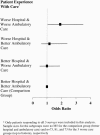Patient-centered processes of care and long-term outcomes of myocardial infarction
- PMID: 11903758
- PMCID: PMC1495308
- DOI: 10.1111/j.1525-1497.2001.10102.x
Patient-centered processes of care and long-term outcomes of myocardial infarction
Abstract
Objective: To examine whether patients' experiences with nontechnical aspects of care such as patient education and discharge planning are associated with long-term outcomes.
Design: Observational cohort study.
Setting: Twenty-three New Hampshire hospitals during 1996 and 1997.
Participants: Acute myocardial infarction (AMI) patients (N=2,272) enrolled prior to discharge.
Measurements: Surveys asking about problems with care and health were mailed to patients 1, 3, and 12 months after discharge. Patients were stratified into "worse" or "better" care groups on the basis of their hospital care problem score. Outcomes included self-reported overall health, physical health, mental health, chest pain, and shortness of breath. Other clinical measures were obtained from hospital discharge abstracts.
Main results: The 1-, 3-, and 12-month surveys were returned by 1,346 (59.2%), 1,046 (46%), and 964 (42.4%) enrolled patients, respectively. The primary analytic cohort consisted of the 762 patients who completed both the 1- and 12-month surveys. After adjustment for postdischarge health status and other clinical factors, patients experiencing worse hospital care had lower ratings of overall health (48.4 vs 52.5 on 100-point scale; P=.02) and physical health (59.7 vs 68.4; P <.001), and were more likely to have chest pain (odds ratio [OR], 1.6; confidence interval [CI], 1.0 to 2.4; P=.04) 12 months after their AMI than other patients. However, differences in reports of chest pain were reduced if patients reporting worse hospital care had better experiences with subsequent ambulatory care.
Conclusions: Patients' experiences with nontechnical processes of AMI hospital care are associated with long-term outcomes; however the association between a negative hospital experience and subsequent chest pain may be offset by more positive outpatient experiences.
Figures
Comment in
-
Processes and outcomes in acute myocardial infarction.J Gen Intern Med. 2001 Dec;16(12):868-9. doi: 10.1111/j.1525-1497.2001.11016.x. J Gen Intern Med. 2001. PMID: 11903769 Free PMC article. No abstract available.
References
-
- Ayanian JZ, Guadagnoli E, McNeil BJ, Cleary PD. Treatment and outcomes of acute myocardial infarction among patients of cardiologists and generalist physicians. Arch Intern Med. 1997;157:2570–6. - PubMed
-
- Marciniak TA, Ellerbeck EF, Radford MJ, et al. Improving the quality of care for Medicare patients with acute myocardial infarction: results from the Cooperative Cardiovascular Project. JAMA. 1998;279:1351–7. - PubMed
-
- Guadagnoli E, Hauptman PJ, Ayanian JZ, Pashos CL, McNeil BJ, Cleary PD. Variation in the use of cardiac procedures after acute myocardial infarction. N Engl J Med. 1995;333:573–8. - PubMed
-
- O'Connor GT, Quinton HB, Traven ND, et al. Geographic variation in the treatment of acute myocardial infarction: the Cooperative Cardiovascular Project. JAMA. 1999;281:627–33. - PubMed
Publication types
MeSH terms
LinkOut - more resources
Full Text Sources
Medical

